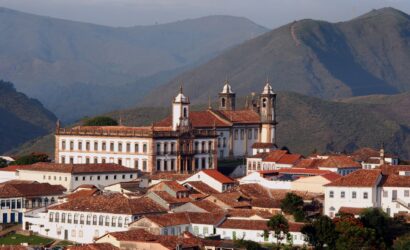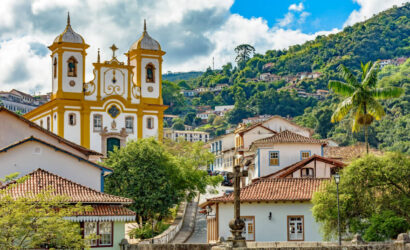Minas Gerais:
Ouro Preto
e Tiradentes
Talking a little about
Ouro Preto is a colonial city in the Serra do Espinhaço, in the eastern region of Brazil. It is renowned for its Baroque architecture, which includes bridges, fountains, and squares, as well as its steep and winding cobblestone streets. The central square, Praça Tiradentes, is named after the martyr of Brazilian independence. There are numerous churches and chapels throughout the city, including the 18th-century Church of São Francisco de Assis.
Talking a little about
Tiradentes is a city in southeastern Brazil. It is known for its colonial Baroque architecture, most notably the Church of Santo Antônio. This church features hundreds of kilograms of gold decoration and a façade designed by the Brazilian sculptor Aleijadinho. Nearby, the Church of Nossa Senhora do Rosário is an 18th-century church built by slaves. Craft shops fill the central square of the city, Largo das Forras.
Region
Southeast
State
Minas Gerais
Climate
Tropical highland
Main attractions
Tourist attractions, museums, and cultural performances
Some
Curiosities (Ouro Preto)
Ouro Preto has been a UNESCO World Heritage Site since 1980 due to its well-preserved colonial baroque architecture and its historical significance as a center of gold mining in the 18th century. Its churches, houses, and stone streets tell the story of Brazil’s colonial era.
The name “Ouro Preto” derives from the intense gold exploration in the region, which left traces of iron oxide in the waters of streams and rivers, giving them a dark color. Originally called “Vila Rica,” the city’s name was changed to Ouro Preto in 1823.
Ouro Preto was an important hub of activities related to the Inconfidência Mineira, a movement for independence against Portuguese colonial rule in the late 18th century. Several leaders of the conspiracy, including Tiradentes, were associated with the city.
The renowned sculptor and carver Aleijadinho left a significant mark on Ouro Preto. His sculptures in churches, such as the Church of São Francisco de Assis, are considered masterpieces of Brazilian baroque art. An interesting curiosity is that the nickname “Aleijadinho” originated from his struggle against a degenerative disease that deformed his hands.
The city is known for its religious and cultural festivals. Holy Week in Ouro Preto is famous for its processions and reenactments of the Passion of Christ, attracting visitors from all over the country. Additionally, Ouro Preto’s Carnival is known for its lively parties and parades through the historic streets.


Some
Curiosities (Tiradentes)
The city was named Tiradentes in honor of Joaquim José da Silva Xavier, better known as Tiradentes. He was one of the leaders of the Inconfidência Mineira, a movement for independence against Portuguese colonial rule in the 18th century.
Tiradentes is famous for its well-preserved colonial architecture. The cobblestone streets, colorful houses, and historic churches create a charming atmosphere that transports visitors back in time.
Annually, Tiradentes hosts the Culture and Gastronomy Festival, one of the most renowned events in Brazil’s culinary scene. National and international chefs come together to celebrate local cuisine and showcase unique and innovative dishes.
Tiradentes is a starting point for the historic Oeste de Minas Railroad, which offers Maria Fumaça (steam train) rides. Tourists can board this steam locomotive and journey through beautiful landscapes and historic towns, such as São João del-Rei.
The city is an important cultural and artistic hub, housing various art galleries, studios, and cultural spaces. Additionally, Tiradentes hosts cultural events such as the Film Festival, attracting filmmakers, actors, and cinema enthusiasts.












